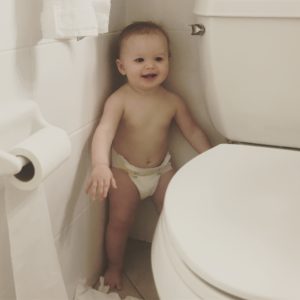Baby Proofing 101
Once your baby is mobile, it’s time to start making some changes around the house to protect your curious little one. Read on for tips from Dr. Jessica Long on best practices for baby-proofing.

There are a lot of ways parenthood changes us but one I did not expect was how drastically different our house would look. Never mind the scooters on the front porch, the chalk drawings on the sidewalk, or the toys strewn everywhere inside and out. There are more subtle differences I never would have guessed like covers on the outlets, gates on the stairs, and not a loose coin to be found. Baby-proofing your home is a huge but important endeavor and it involves changing habits and routines you never really knew you had.
How do you even start making your home safe for your little one who, at a very young age, can (and will) start reaching for things and sticking them in her mouth? Suddenly a benign water bottle lid becomes a potential choking hazard. The dog food bowl becomes your child’s most desired possession. And don’t get me started on how every electric cord in the house suddenly becomes a beacon of fun.
As you prepare to baby-proof, I recommend looking in each room in your house, ideally from the much lower viewpoint of your child, to see what potential dangers there are. There are obvious things like installing baby gates at the top and bottom of all stairs but also more subtle hazards like window blind cords that should be tucked out of reach. In bedrooms and living rooms, make sure furniture is secured to the wall so that your curious child does not accidentally topple it over when trying to pull up on it. The same goes for TVs, which are notorious for causing injuries to young children.
In kitchens and bathrooms, invest in strong cabinet and drawer locks so that curious hands do not find medications or cleaners. When possible, store toxic or poisonous substances up high as well as locked away to minimize the chances of your little one accidentally getting ahold of them. Outlets should be covered and electrical cords should be taped down or hidden behind furniture so as not tempt curious babies.
One of the big changes that needs to be made, and maintained over time, is keeping choking hazards out of your child’s reach. Gone are the days where you can toss loose change on the table without thinking or absent-mindedly leave batteries on the counter – both pose serious threats to your child. When ridding your space of choking hazards, use the toilet paper roll rule. If an item is small enough to fit through the cardboard tube, it should be placed out of reach of your child. While this is a routine that can take time to master, it will soon become second nature and ensures your child can crawl, walk, climb and explore in a safe space.
Once you’ve seemingly covered your house in bubble wrap, the next step is seeing what your child gets into. All the baby-proofing in the world doesn’t replace good adult supervision, and watching your child will reveal new hazards to abate Plus, every child is different, so while your first may never have looked at an outlet, your second may be found licking one (true story). You will likely continue to update and change your safety precautions as needed and as your child grows.


